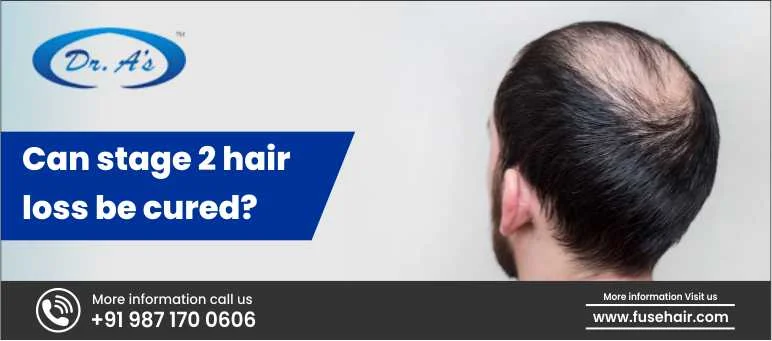
Hair loss is a very common concern affecting individuals of all ages and backgrounds. Understanding the different types of hair loss and their underlying causes is essential for effective management and treatment. From genetic predispositions like androgenetic alopecia to conditions such as telogen effluvium and traction alopecia, each type presents unique challenges that require unique and personalized care.
In this article, we will look into various types of hair loss, their characteristics, and the factors contributing to their development, providing valuable insights for individuals seeking solutions to their hair loss concerns.
Different Types of Hair Loss and its Causes
Here are some different types of hair losses and their causes:
-
Androgenetic Alopecia
Androgenetic alopecia, commonly known as male pattern hair loss or female pattern hair loss, is a hereditary condition characterized by gradual hair thinning and potential balding in specific patterns. In men, this often starts with a receding hairline and progresses to hair loss at the crown, eventually leaving a horseshoe-shaped pattern of hair around the sides and back of the head. Women with androgenetic alopecia typically experience diffuse thinning across the scalp without significant recession of the hairline.
The exact cause of androgenetic alopecia involves a combination of genetic predisposition and hormonal factors. While researchers have identified androgens, particularly dihydrotestosterone (DHT), as playing a crucial role, the full spectrum of contributing factors remains unclear. Androgens regulate the hair growth cycle, influencing the length and thickness of hair strands. Excessive stimulation of hair follicles by androgens can shorten the growth phase, delay the growth of new hair, and result in thinner and shorter strands, eventually leading to visible hair loss.
You can visit Dr. A’s Clinic to consult with our skilled surgeons specializing in hair disorders, accurate diagnosis, and personalized treatment plans tailored to individual needs and goals.
-
Telogen Effluvium
Telogen effluvium is another different type of hair loss characterized by an increased number of hair follicles entering the resting phase (telogen) of the hair growth cycle without progressing to the next growth phase. This leads to excessive shedding of hair all over the scalp, resulting in noticeable thinning, especially around the crown and temples. While telogen effluvium typically does not lead to complete baldness, individuals may lose between 300 to 500 hairs per day during this phase.
Various medical events or conditions can trigger telogen effluvium, such as thyroid imbalances, childbirth, surgery, fever, vitamin or mineral deficiencies (e.g., iron deficiency), and certain medications like isotretinoin (used for acne), warfarin (a blood thinner), or changes in oral contraceptives (birth control pills). The onset of telogen effluvium usually occurs around three months after the triggering event.
In many cases, hair loss due to telogen effluvium is temporary, and hair may regrow naturally within six months after the triggering factor is resolved. However, if hair loss persists beyond six months or becomes chronic, dermatologists can offer medical interventions to promote hair regrowth. Treatment options may include medications to stimulate hair follicles and support the growth of new hair strands. Consulting with a dermatologist is crucial for proper diagnosis and tailored treatment plans for telogen effluvium.
-
Anagen Effluvium
Anagen effluvium is characterized by the disruption of cell division in the hair matrix, leading to narrowed hair strands that are prone to breakage near the base. This condition can occur due to various insults that impair the mitosis of hair follicle keratinocytes. The damaged hair matrix forms plugs containing melanin, keratin, and inner root sheath components, which are then expelled through the follicular opening in a process called trichomalacia.
The primary causes of anagen effluvium include infections, drugs, toxins, radiation exposure, or autoimmune diseases. Infections can locally interrupt hair growth, resulting in bald patches that may be swollen, crusted, and easily pluckable. Examples of infections that can lead to anagen effluvium include boils, abscesses, and fungal hair infections like tinea capitis or kerion.
Identifying and addressing the underlying cause of anagen effluvium is crucial for effective management and potential hair regrowth. Visit Dr. A’s Clinic, the best hair transplant in Delhi, for accurate diagnosis and appropriate treatment strategies tailored to individual needs.
-
Alopecia Areata
Alopecia areata is an autoimmune disorder where the body’s immune system mistakenly attacks healthy hair follicles, resulting in hair loss and inhibiting new hair growth. This condition can affect individuals of all ages and often manifests with sudden and unexpected hair loss in small patches on the scalp, which is typically painless. Moreover, hair loss may extend to other areas of the body, such as the eyebrows and eyelashes.
As the condition progresses, some individuals may experience alopecia totalis, which refers to complete hair loss on the scalp. The severity and extent of hair loss can vary widely among individuals, ranging from isolated patches to widespread baldness, resulting in different types of alopecia.
The exact cause of alopecia areata is not fully understood, but it is believed to involve a combination of genetic factors and triggers such as viral infections or environmental factors. The immune system mistakenly identifies hair follicles as foreign invaders, leading to their destruction and subsequent hair loss.
-
Cicatricial Alopecia
Cicatricial alopecia, also known as scarring alopecia, is a rare form of hair loss characterized by inflammation that destroys hair follicles and results in the formation of scar tissue, preventing hair regrowth. The onset of hair loss in cicatricial alopecia can be gradual or sudden, accompanied by symptoms like severe itching, scalp lesions, swelling, and redness.
This condition can affect individuals of any age, although it is more commonly observed in adults than in children. The primary cause of cicatricial alopecia is inflammation, which can result from various factors such as autoimmune reactions, trauma (e.g., burns or infections), or other inflammatory conditions affecting the scalp.
The inflammatory process involves different types of immune cells, including lymphocytes and natural killer cells, contributing to the destruction of hair follicles and subsequent scarring (fibrosis). Although the exact causes of cicatricial alopecia are not fully understood, early intervention is crucial to prevent further fibrosis and permanent hair loss.
-
Hair Shaft Abnormalities
Hair shaft abnormalities encompass various conditions that affect the structure and strength of hair strands, leading to increased vulnerability to breakage and hair loss. Unlike other types of hair loss that originate from the follicle, hair shaft abnormalities result from damage or weaknesses along the visible part of the hair.
One type of hair shaft abnormality is loose anagen syndrome, commonly seen in children, where hair lacks a firm root in the follicle, making it easy to pull out. This condition often resolves with age and may require minimal intervention.
Trichotillomania is a psychological disorder characterized by the compulsive urge to pull out one’s hair, leading to patchy hair loss. Psychotherapy is often recommended as the primary treatment to address underlying triggers and behaviors.
Traction alopecia occurs due to hairstyles that exert excessive tension on the hair shaft, causing breakage and hair loss. Changing hairstyles and reducing tension can help reverse this condition and promote hair regrowth.
-
Tinea Capitis
Tinea capitis, commonly known as scalp ringworm, is a fungal infection caused by dermatophytes, specifically Microsporum and Trichophyton species. These mold-like fungi thrive in warm and moist environments, making tropical regions ideal for their growth.
The infection spreads easily through direct contact with infected individuals, animals, contaminated objects, and surfaces harboring the fungus. Children are particularly susceptible to tinea capitis due to their frequent contact with potentially contaminated environments. Additionally, the fungus can persist on infected objects and surfaces for extended periods, contributing to its easy transmission.
Symptoms of tinea capitis include scalp itching, redness, scaling, and hair loss, often in circular or patchy patterns. Prompt diagnosis and treatment are crucial to prevent the spread of infection and alleviate symptoms. Antifungal medications, both oral and topical, are typically prescribed to eradicate the fungus and promote hair regrowth in affected areas.
Conclusion
Understanding the various types of hair loss and their underlying causes is crucial for effective diagnosis and treatment. From common conditions like androgenetic alopecia to less frequent issues such as cicatricial alopecia and hair shaft abnormalities, each type requires personalized care and intervention. Consulting with professionals can provide the expertise needed to identify the specific type of hair loss and develop tailored treatment plans to promote healthy hair regrowth and improve overall hair health.
Dr. A’s Clinic, the best hair transplant clinic in Delhi, provides comprehensive and specialized care for a wide range of hair and scalp disorders, employing advanced diagnostic tools and effective treatment modalities. Whether you’re dealing with common conditions like any type of alopecia areata or more complex issues such as cicatricial alopecia, our clinic is equipped to diagnose, manage, and treat various types of hair loss and abnormalities.
FAQs
How do I know what type of hair loss I have?
Determining your type of hair loss requires a dermatologist’s evaluation, who may conduct physical exams, blood tests, or scalp biopsies. They’ll identify if it’s genetic (androgenetic alopecia) due to medical conditions, stress, or lifestyle factors.
What is type 3 hair loss?
Type 3 hair loss refers to the Norwood-Hamilton Scale for male pattern baldness, characterized by a receding hairline and thinning at the temples. It’s a common pattern seen in men experiencing androgenetic alopecia.
What are the top 3 for hair loss?
The top three causes of hair loss are androgenetic alopecia (genetic), telogen effluvium (stress or medical triggers), and alopecia areata (an autoimmune condition). Proper diagnosis by a healthcare professional is crucial for effective treatment.
What type of hair loss is permanent?
Androgenetic alopecia, commonly known as male or female pattern baldness, is often permanent. It’s genetic and results from the hormone dihydrotestosterone (DHT) affecting hair follicles, leading to progressive thinning and loss.
How much hair fall is normal in a day?
On average, losing 50-100 hairs per day is considered normal. Factors like washing, brushing, and natural hair growth cycles contribute to daily hair fall. However, significant deviations from this range may indicate underlying issues requiring medical attention.












































